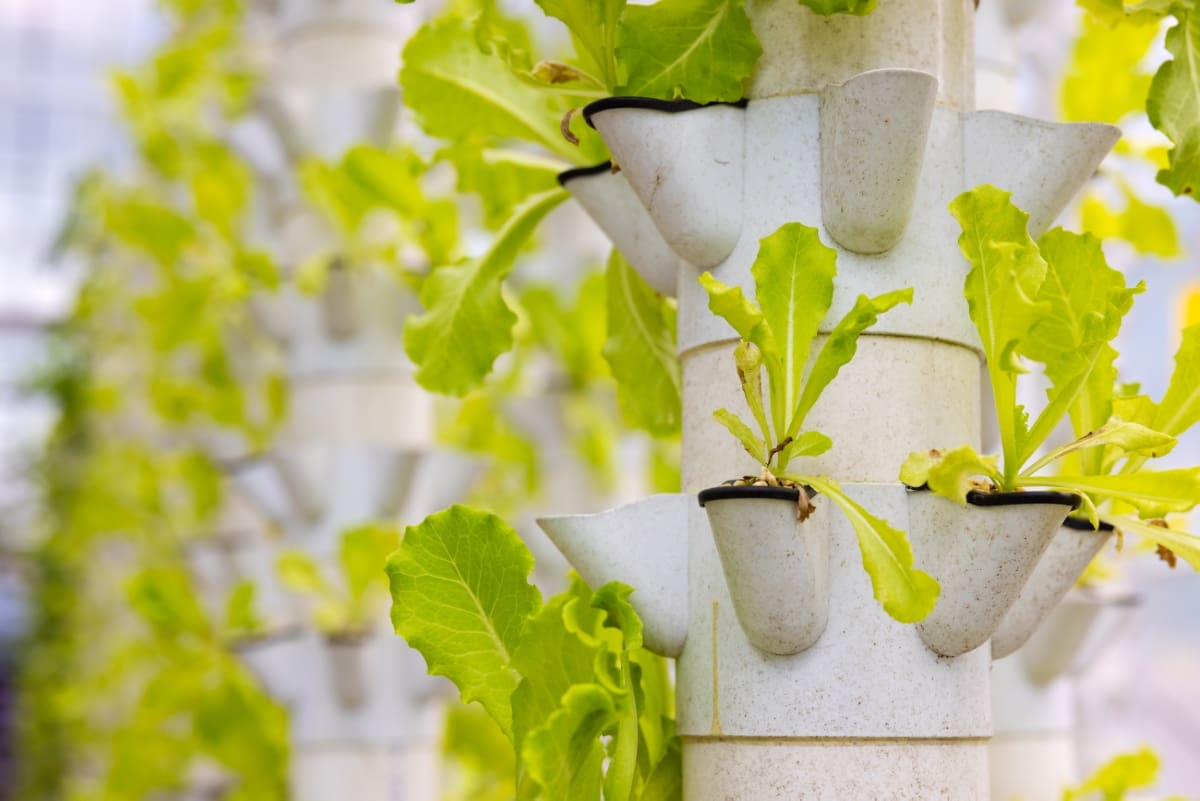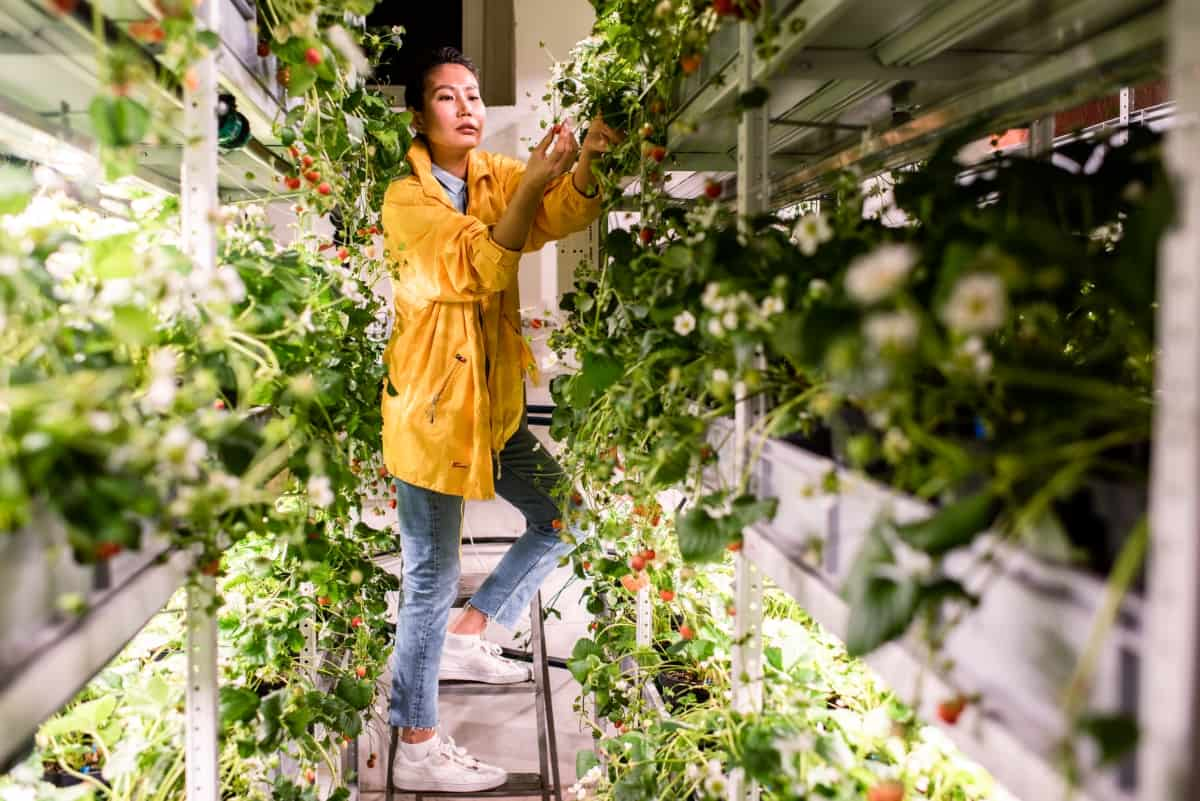Tower gardening and vertical farming have emerged as innovative solutions to address the challenges of limited space, food security, and environmental sustainability in urban areas across Africa. With its ability to maximize productivity using minimal land, tower gardening has the potential to revolutionize urban green spaces and transform them into thriving hubs of sustainable agriculture.

Tower Gardening in Africa
Understanding the Concept of Vertical Farming
Vertical farming gained immense popularity in recent years. Vertical farming is cultivating plants in vertically stacked layers using hydroponic or aeroponic systems. This innovative approach allows for maximum use of space, making it ideal for urban areas where land availability is limited. In vertical farms, crops are grown indoors under controlled environments with artificial lighting and climate control systems.
This eliminates the need for traditional soil-based agriculture and opens endless possibilities for growing a wide range of crops year-round. By knowing the Step-by-Step Vertical Farming Guide utilizing vertical space efficiently, farmers can significantly increase their productivity compared to traditional farming methods. Moreover, because these farms operate indoors, they are not subject to weather conditions or seasonal constraints.
Advantages of Vertical Farming in Africa
Vertical farming has emerged as a promising solution for addressing food security and sustainability challenges in Africa. With its numerous advantages, this innovative agricultural practice is gaining popularity across the continent. One of the advantages of vertical farming in Africa is its ability to maximize limited space. As urban areas continue to expand rapidly, arable land becomes scarce. Vertical farms offer a viable alternative by utilizing vertical space rather than relying solely on horizontal cultivation methods.
By stacking crops vertically, farmers can grow more produce using less land, making it an ideal option for densely populated cities. Another advantage is the year-round production that vertical farming offers. Traditional agriculture often faces limitations due to seasonal changes and weather conditions. In contrast, vertical farms provide controlled environments where temperature, lighting, and humidity can be adjusted according to crop requirements. This allows for consistent production throughout the year, regardless of external factors.
One of the main reasons why Vertical Crop Cultivation Africa is gaining popularity in Africa is due to the rapid urbanization taking place across the continent. Vertical farming also reduces water usage compared to conventional agriculture methods. Through hydroponics or aeroponics systems used in tower gardens, plants are grown without soil and require significantly less water than traditional soil-based cultivation.
Tower Farming: A Suitable Model for African Countries
Tower farming, also known as vertical farming, is a revolutionary agricultural practice that has gained traction in various parts of the world. Africa faces unique challenges when it comes to agriculture. Limited arable land, unpredictable weather patterns, and rapid urbanization are just some of the factors that have hindered traditional farming practices. Tower farming offers a solution by utilizing vertical space rather than horizontal land.
One of the key advantages of tower farming in Africa is its ability to maximize productivity in limited spaces. By using vertical structures such as towers or multi-level platforms, farmers can grow crops vertically rather than horizontally. This allows them to produce higher yields per square meter compared to traditional methods. Furthermore, tower farms can be established in urban areas, bringing agriculture closer to consumers and reducing transportation costs. This proximity not only ensures fresh produce but also creates employment opportunities within communities.
Site Selection and Design Considerations for Tower Farms in Africa
When it comes to setting up tower farms Agriculture in Africa, site selection plays a crucial role. The success of vertical farming depends on various factors, including access to sunlight, water availability, and proximity to urban areas. Selecting the right location ensures optimal conditions for plant growth and maximizes the efficiency of the farm.
One key consideration is sunlight exposure. Tower farms require ample sunlight for photosynthesis to occur, so selecting a site with unobstructed access to sunlight is essential. Water availability is another critical factor. Vertical farming relies heavily on efficient irrigation systems that deliver water directly to plants’ roots. Therefore, choosing a site near a reliable source of water or implementing proper water storage solutions is vital.
In case you missed it: Growing Vegetables In South Africa, Sowing Calendar

Additionally, proximity to urban areas should be considered when selecting a site for tower farms in Africa. Urban centers provide ready markets for fresh produce and reduce transportation costs. Being close to consumers also promotes sustainable agriculture practices by minimizing food miles and carbon emissions. Design considerations are equally important when setting up tower farms in Africa. Maximizing space utilization through vertical stacking systems allows more crops to be grown within limited land areas effectively.
Legal and Regulatory Framework for Vertical Farming in Africa
In Africa, where agriculture is a significant contributor to many economies, it’s essential to establish clear guidelines for vertical farming practices. One of the primary considerations in developing these frameworks is ensuring that they align with existing agricultural laws while also addressing the unique aspects of vertical farming.
This involves defining key terms related to this innovative farming method and establishing guidelines for land use, water rights, waste management, and crop safety. Additionally, regulations must address issues such as licensing requirements for operating tower farms and certifications for produce grown using this technique.
It’s important to ensure that consumers have confidence in the safety and quality of vertically farmed products. Collaboration between government agencies, research institutions, and industry stakeholders is critical in formulating effective legal frameworks. Engaging experts from various fields can help policymakers understand the potential benefits of vertical farming while also considering any environmental or health concerns associated with its implementation.
Moreover, governments should explore incentives such as tax breaks or subsidies to encourage investments in vertical farming infrastructure. These measures can attract both local entrepreneurs seeking expansion opportunities and foreign investors interested in supporting sustainable agriculture initiatives on the continent.
Urban Agriculture and Food Security in Africa
Africa is a continent that faces numerous challenges when it comes to food security. The rise of urban agriculture, particularly through Tower Farming Techniques Africa, has brought about new opportunities for ensuring food security in African cities. Advantages of Urban Agriculture in Africa is its ability to provide fresh produce directly to local communities. By growing crops within city limits, transportation costs are reduced significantly, and vegetables can be harvested at their peak freshness.
This not only improves access to nutritious foods but also reduces reliance on imported goods. Moreover, African Urban Agriculture Tips empowers individuals and communities by providing them with the means to grow their food. In many African cities where poverty rates are high, this can make a significant impact on household budgets and overall well-being. Additionally, community gardens foster a sense of belonging and collaboration among residents.
In case you missed it: How To Start Backyard Vegetable Garden In Africa

Financing and Investment Opportunities in Tower Farming in Africa
Financing and investment opportunities in tower farming in Africa are gaining significant attention from both local and international investors. To attract investment capital, entrepreneurs looking to venture into tower farming need to develop comprehensive business plans that outline their projected financials, growth strategies, and market analysis. Demonstrating a clear return on investment potential will be crucial in securing funding from banks or private investors.
Furthermore, partnerships with government agencies or non-profit organizations can provide access to grants or subsidies that support agricultural initiatives focused on food security and sustainability. These collaborations not only offer financial assistance but also enhance credibility within the industry.
Investors should also consider exploring innovative financing models such as crowdfunding or impact investing platforms specifically targeting sustainable agriculture projects. These alternative sources of funding have gained popularity globally as they align with socially responsible investing principles.
Challenges and Opportunities in Tower Farming in Africa
Tower farming has gained significant traction across Africa as a sustainable solution for urban agriculture. However, like any innovative practice, it comes with its own set of challenges and opportunities. One major challenge is the initial investment required to set up an African Tower Farm. The high costs associated with purchasing vertical farming systems and equipment can be a barrier for many small-scale farmers. Additionally, access to quality seeds, fertilizers, and other inputs may also pose a challenge in some regions.
Another challenge is the limited technical expertise and knowledge about tower farming techniques among farmers. Training programs and workshops aimed at educating farmers on best practices are crucial to ensure the successful implementation of vertical farming methods. Implementing irrigation systems that minimize water usage is essential for sustainable tower farming.
The Future of Vertical Farming in Africa
The future of vertical farming in Africa holds great promise and potential. Vertical farming offers a solution that utilizes limited space efficiently, making it suitable for densely populated cities. With advancements in technology and innovation, vertical farming systems are becoming more affordable and accessible. This opens opportunities for small-scale farmers and urban dwellers to participate in food production while reducing their reliance on traditional agricultural practices.
In addition, vertical farming can help address some of the challenges faced by African countries, such as climate change and water scarcity. Controlled environment agriculture allows farmers to optimize growing conditions, ensuring consistent crop yields regardless of external factors. Furthermore, vertical farms have the potential to enhance food security by providing fresh produce year-round. By eliminating the need for long-distance transportation from rural areas to cities, these farms reduce carbon emissions associated with conventional agriculture.
In case you missed it: Guide to Growing African Violets from Seeds: Problems, Plant Care

Conclusion
Vertical farming is on the rise in Africa, with tower gardening at the forefront of this innovative agricultural practice. Through vertical farming, African countries are elevating urban green spaces and addressing food security challenges. This Sustainable Farming Africa offers numerous advantages, including efficient land use, reduced water consumption, year-round production, and decreased reliance on pesticides.
- How to Grow Hibiscus from Flower
- Plantation Ideas for Home Decoration: A Beginners Guide
- Flower Garden Designs and Layouts for Beginners
- Planting and Spacing Techniques in Papaya: A Beginner’s Guide
- Growing Gold: Essential Techniques for Planting Pineapples
- How to Make Kalanchoe Plant Bushy: Home Remedies and Solutions
- 11 Reasons Why Your Gardenia is Not Blooming: Home Remedies and Solutions
- Eco Elegance: The Guide to Designing a Drought-Tolerant Landscape
- Gardening on a Slope: Strategies for Hillside Landscaping